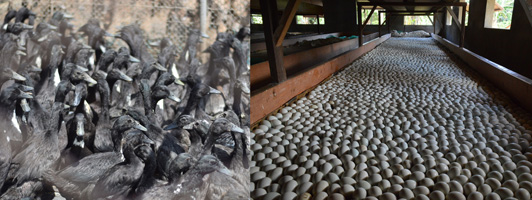 Research and development for the genetically superior breeder duck called Itik Pinas has its new home at Barangay Lagalag, Tiaong, Quezon.
Research and development for the genetically superior breeder duck called Itik Pinas has its new home at Barangay Lagalag, Tiaong, Quezon.
The Itik Pinas research and development (R&D) facility located at the National Swine and Poultry Research and Development Center of the Bureau of Animal Industry (BAI-NSPRDC) was inaugurated, with DOST Undersecretary for R&D Rowena Cristina L. Guevara as the guest of honor.
“DOST-funded projects should reach farmers. The projects will be useless when farmers cannot benefit,” Guevara said. “Earlier, I talked with some of the farmers and were surprised that there are several overseas Filipino workers (OFWs) who went home, stayed, and made duck raising as their main source of livelihood. It would be great if more OFWs go home and consider venturing into duck raising.”
The facility was an output of the partnership of BAI-NSPRDC and the Philippine Council for Agriculture, Aquatic and Natural Resources Research and Development of the Department of Science and Technology (DOST-PCAARRD). It will enable the continued genetic improvement of Itik Pinas, increase the availability of genetically superior layer ducks, and ensure consistent product quality.
Moreover, according to the citation included in the marker of the facility, “the facility is a solid proof of the gains earned from the friendly partnership between two government agencies with the end goal of uplifting Philippine duck industry.”
 This was also part of the message of the PCAARRD Acting Executive Director, Dr. Reynaldo V. Ebora. “In PCAARRD, the ‘P’ and ‘C’ have a different meaning: it’s partnership and collaboration. This facility is one example. The project that developed Itik Pinas is not just developed by PCAARRD or BAI, it’s a collaboration,” Ebora said.
This was also part of the message of the PCAARRD Acting Executive Director, Dr. Reynaldo V. Ebora. “In PCAARRD, the ‘P’ and ‘C’ have a different meaning: it’s partnership and collaboration. This facility is one example. The project that developed Itik Pinas is not just developed by PCAARRD or BAI, it’s a collaboration,” Ebora said.
Itik Pinas is an offshoot of DOST-PCAARRD’s Industry Strategic S&T Program (ISP) on Duck, which aims to address the low and inconsistent egg production performance and product quality of the “mongrel” ducks as an effect of long term indiscriminate breeding practices of the duck industry.
Compared with traditional ducks, Itik Pinas produces more eggs of up to 65 pieces per duck per year over that of the traditional mongrel ducks. Itik Pinas eggs is also consistent in terms of egg weight with at least 85% of egg produced weigh 65 grams or more.
Itik Pinas has three developed strains – two of which are purelines known as IP-Itim and IP-Khaki and one commercial hybrid line, IP-Kayumanggi.
